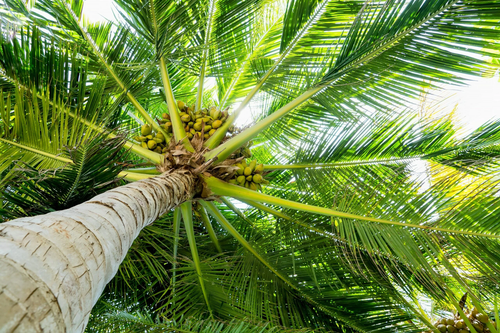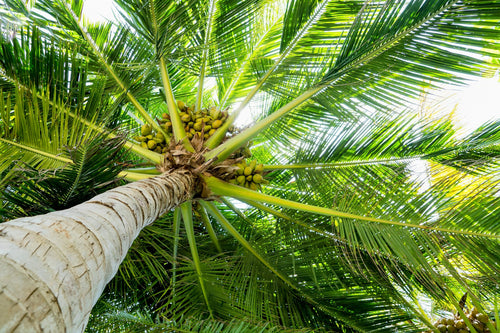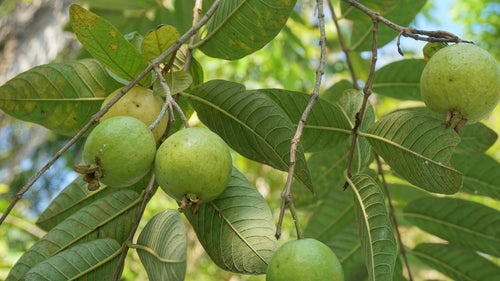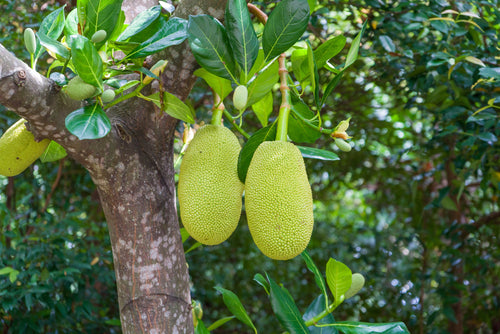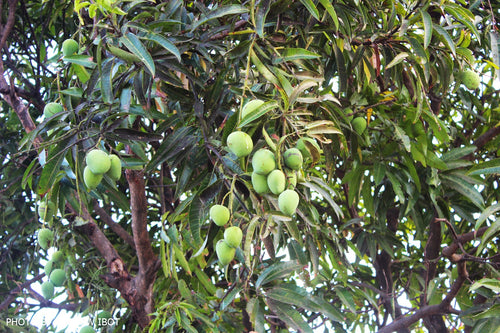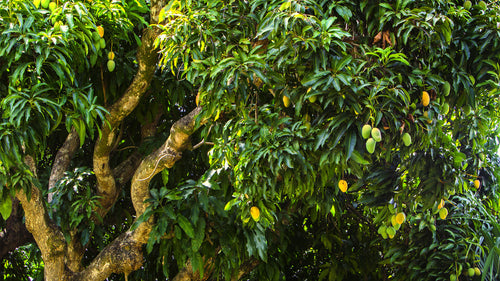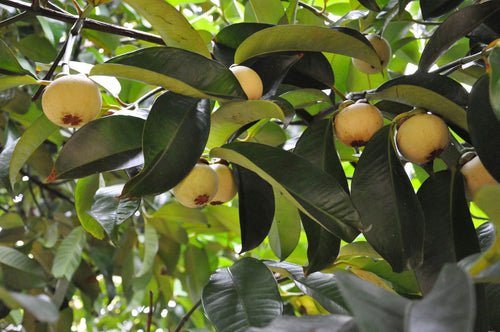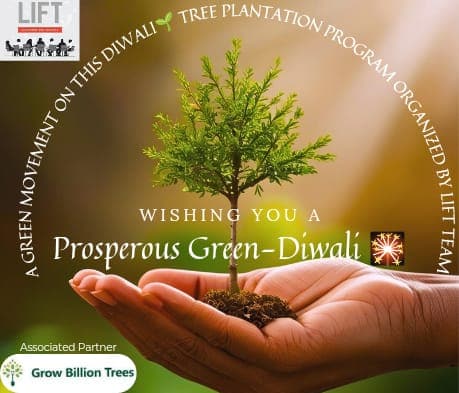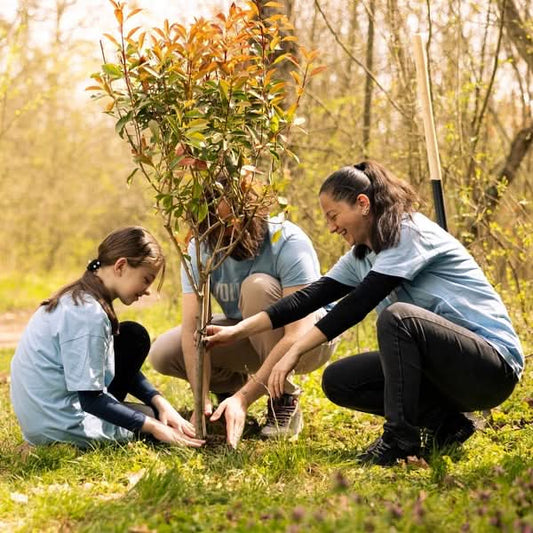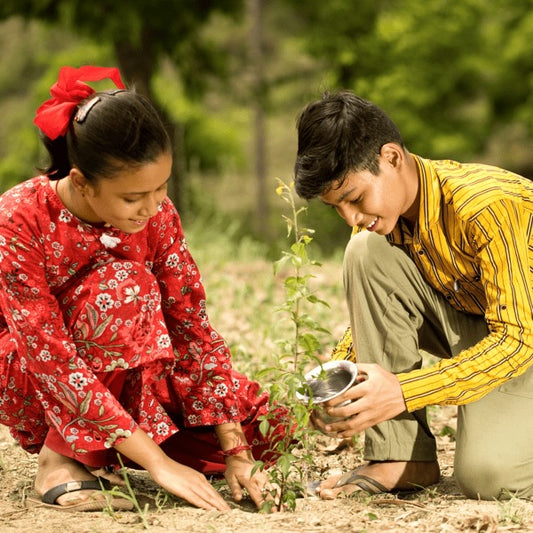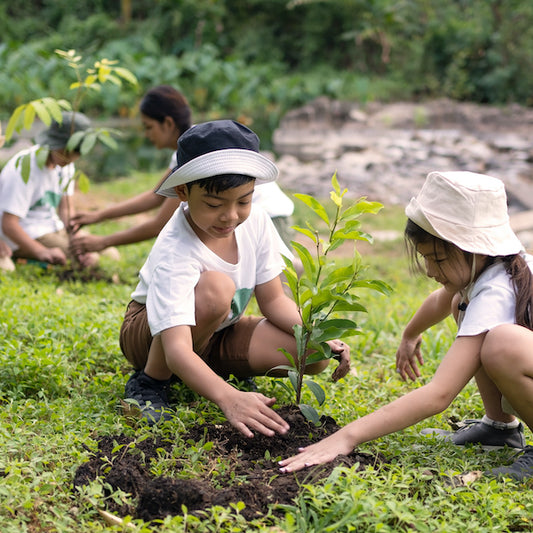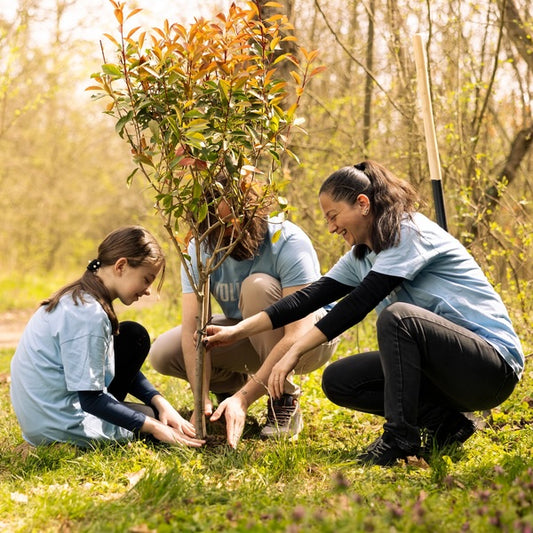Sakshi’s Thoughtful Gesture: Nurturing Nature for Akash’s 51st Birthday
To celebrate her husband Akash’s 51st birthday, Sakshi embarked on a meaningful journey by planting trees in an agroforest setting. This initiative wa Read more
Project Update 1


Digital Forest
Forest with 51 Trees planned
Want to plant Trees for Birthday Celebration now?
Plant a Tree @ 299Sakshi’s Thoughtful Gesture: Nurturing Nature for Akash’s 51st Birthday
To celebrate her husband Akash’s 51st birthday, Sakshi embarked on a meaningful journey by planting trees in an agroforest setting. This initiative was not just a tribute to Akash but also a step towards promoting environmental sustainability and supporting the local farming community.
The agroforestry approach combines tree planting with agricultural activities, creating a harmonious ecosystem that benefits farmers and the environment alike. The planted trees not only sequester carbon and enhance biodiversity but also provide shade, prevent soil erosion, and improve soil fertility. For farmers, agroforestry delivers direct economic advantages through increased crop yields, sustainable timber production, and the cultivation of fruit and fodder.
By choosing an agroforest concept, Sakshi has contributed to empowering farmers with diversified income sources while also creating a green legacy for Akash. This act reflects a deep understanding of how personal milestones can be celebrated in a way that leaves a lasting impact on people and the planet.
Sakshi’s initiative is a shining example of how individuals can align personal joy with global sustainability, nurturing both nature and livelihoods.
Tree Plantation Date
8th April 2024
Plantation Location
Sahayadri Van, Girvi, Satara, Maharashtra 415523
Trees Planted
Total Count: 51 Trees
Species Name: Mango, Guava, Chiku, Jackfruit, Coconut
Forest Type: Agroforest
To celebrate her husband Akash’s 51st birthday, Sakshi chose a meaningful and sustainable gift by planting trees in an agroforest. This initiative not only marked a personal milestone but also supported a farmer-centric approach to environmental stewardship. Agroforestry integrates trees with agricultural practices, offering multiple benefits such as enhancing soil fertility, reducing erosion, and providing shade for crops and livestock. For farmers, it serves as a vital source of diversified income through sustainable timber, fruits, and fodder production. By opting for this thoughtful gesture, Sakshi contributed to empowering local farmers while fostering a greener planet, creating a gift that nurtures both nature and livelihoods.
Advantages Of Agroforest
Enhanced Income Diversification
Agroforestry enables farmers to generate income from multiple sources by integrating trees with crops and livestock. Farmers can benefit from the sale of fruits, nuts, timber, and medicinal plants. This diversification reduces reliance on a single crop or income source, providing financial stability and security against market fluctuations or crop failures.
Improved Livelihood Resilience
By incorporating trees into farmlands, agroforests help farmers adapt to changing climatic and economic conditions. Trees provide a dependable source of resources, such as timber and fodder, that remain valuable even in challenging times. This resilience ensures that farmers can sustain their livelihoods despite adverse weather or agricultural setbacks.
Reduced Farming Costs
Agroforests contribute to natural soil enrichment through leaf litter and organic matter, minimizing the need for expensive chemical fertilizers. Additionally, the shade provided by trees helps regulate soil temperature and moisture, reducing the need for excessive irrigation. By fostering natural pest control through biodiversity, agroforestry also lowers the dependence on chemical pesticides, making farming more cost-effective.
Improved Soil Health and Productivity
Tree roots prevent soil erosion by stabilizing the soil, while leaf litter improves its fertility by adding essential nutrients. This enhanced soil quality increases crop yields sustainably and ensures long-term agricultural productivity.
Carbon Sequestration and Climate Mitigation
Trees in agroforests absorb significant amounts of carbon dioxide, playing a vital role in reducing greenhouse gas concentrations in the atmosphere. By mitigating climate change impacts, agroforestry contributes to a healthier planet for future generations.
Water Conservation and Management
Agroforestry systems improve water retention in the soil, reduce surface runoff, and recharge groundwater levels. This ensures a reliable water supply for agricultural and domestic use, even in regions prone to water scarcity.
Biodiversity Enhancement
Agroforests serve as habitats for diverse species of plants, animals, birds, and insects. This biodiversity supports pollination, pest control, and ecological balance, making the entire farming system more sustainable.
Climate Resilience
Trees act as natural shields against extreme weather conditions like storms, heavy rainfall, and droughts. They protect crops and reduce the vulnerability of farmland to weather-related damages, ensuring steady agricultural output.
Empowerment of Farmers and Communities
Agroforestry empowers farmers by providing them with sustainable resources for personal use and market sale, such as timber and fuelwood. It also fosters a sense of ownership and stewardship over the land, encouraging communities to adopt sustainable practices that benefit both people and the environment.
Long-Term Environmental and Social Impact
Initiatives like Sakshi’s tree plantation for her husband’s birthday not only create a green legacy but also inspire others to follow suit. By aligning personal celebrations with sustainability goals, such actions help raise awareness about agroforestry's potential to improve livelihoods, combat climate change, and foster community well-being.
Activities During Tree Plantation
During the tree plantation initiative in the agroforest concept, all activities were expertly managed and executed by farmers to ensure sustainable and effective implementation. The process began with site preparation, where the farmers cleared the land of debris, marked planting spots, and enriched the soil with organic matter to enhance its fertility. The farmers meticulously dug planting pits, ensuring proper spacing for optimal growth, and then carefully planted the selected diverse tree species saplings suitable for agroforestry, including fruit-bearing, timber, and nitrogen-fixing varieties, ensuring a balanced ecosystem. Post-plantation care included watering the saplings, installing protective measures against pests, and creating natural barriers to prevent soil erosion. This farmer-driven approach not only ensured the successful establishment of the agroforest but also highlighted the role of experienced hands in creating a sustainable and productive environment.
Tree Plantation Purpose
Sustainable Development Goals (SDGs) Achieved Through Sakshi’s Tree Plantation Initiative in Agroforest Manner:
1. SDG 1: No Poverty
Sakshi’s tree plantation initiative supports farmers in building diversified income streams through agroforestry. By planting fruit-bearing, timber, and medicinal trees, farmers are able to access a variety of marketable products, reducing their reliance on a single crop. This diversification provides financial security, ensuring that the community is less vulnerable to crop failures or market fluctuations, thus contributing to poverty reduction in rural areas.
2. SDG 2: Zero Hunger
Agroforestry systems improve food security by combining the benefits of tree cultivation with agricultural production. The fruit trees planted in the agroforest provide a steady source of nutrition for farming families, while the enhanced soil quality and biodiversity boost crop yields. This integrated approach ensures a more reliable and diverse food supply, supporting the well-being of both farmers and the wider community.
3. SDG 3: Good Health and Well-Being
The agroforestry initiative contributes to improved health by enhancing the quality of the environment. Trees help reduce air pollution by absorbing carbon dioxide and releasing oxygen, which improves air quality. Additionally, the fruits, herbs, and medicinal plants grown in the agroforest provide natural sources of nourishment and health benefits, contributing to the overall well-being of local populations by promoting better nutrition and access to holistic healthcare.
4. SDG 5: Gender Equality
This agroforest initiative plays a pivotal role in promoting gender equality, especially in rural communities where women’s participation in agriculture is often limited. By involving women in the planning, planting, and maintenance of the agroforest, the initiative empowers them economically and socially. Women gain access to income-generating opportunities, as they can also engage in the sale of tree products like fruits, medicinal plants, and timber, contributing to a more gender-balanced economic environment.
5. SDG 8: Decent Work and Economic Growth
The agroforest project creates a range of job opportunities for farmers and laborers, from planting trees to maintaining them and harvesting their products. It also encourages local economic development by fostering a sustainable and diversified economy, which includes sustainable timber, fruit production, and eco-tourism. These activities provide long-term, stable employment, thereby contributing to economic growth while ensuring that the work is both decent and sustainable.
6. SDG 12: Responsible Consumption and Production
Agroforestry inherently promotes responsible consumption and production by encouraging sustainable agricultural practices. The initiative reduces the dependency on synthetic fertilizers and pesticides, as the trees naturally improve soil fertility and provide natural pest control. The agroforest also fosters a circular economy by using organic waste to enrich the soil and ensure that natural resources are used responsibly, thereby minimizing the environmental footprint of agricultural activities.
7. SDG 13: Climate Action
By planting trees in the agroforest, Sakshi’s initiative directly contributes to climate action. Trees act as carbon sinks, absorbing significant amounts of carbon dioxide from the atmosphere and mitigating the effects of climate change. In addition to reducing greenhouse gases, the agroforest helps protect the land from erosion, regulates microclimates, and provides a buffer against extreme weather events like floods or droughts. These climate-resilient practices are crucial for both environmental and community stability in the face of climate change.
8. SDG 14: Life Below Water
Agroforestry contributes to the health of aquatic ecosystems by preventing soil erosion and reducing water runoff. The trees act as natural barriers, absorbing excess water and reducing the amount of sediment that enters rivers, lakes, and streams. This helps to protect water quality and preserve aquatic habitats, ensuring that both freshwater resources and the species that depend on them remain healthy and sustainable.
9. SDG 15: Life on Land
The tree plantation initiative in the agroforest is a key driver of biodiversity conservation. By integrating trees with crops, the initiative creates a diverse and sustainable ecosystem, which helps protect various plant and animal species. This approach also aids in the restoration of degraded land by improving soil quality, increasing organic matter, and preventing erosion. Agroforestry practices, like the one initiated by Sakshi, play an essential role in reversing land degradation and promoting the sustainable use of terrestrial ecosystems.
10. SDG 17: Partnerships for the Goals
Sakshi’s partnership with Grow Billion Trees has played a crucial role in achieving the SDG of Partnerships for the Goals. By collaborating with Grow Billion Trees, Sakshi has helped scale up the impact of her agroforest tree plantation initiative, uniting resources, expertise, and support from a network of like-minded individuals and organizations. This partnership has enabled the project to reach a broader community, empowering local farmers with the knowledge and resources needed for sustainable tree planting. Through this collaboration, Sakshi has contributed to the creation of a more resilient agricultural ecosystem, while also inspiring others to adopt eco-friendly practices, thereby driving collective action toward achieving long-term environmental sustainability and addressing the global climate crisis. The partnership exemplifies how working together, across sectors and regions, can accelerate the progress toward achieving the SDGs, particularly in the areas of environmental conservation and sustainable livelihoods.
ESGs Achieved Through Agroforestry
Environmental (E)
Sakshi's tree plantation initiative in the agroforest concept brings significant environmental benefits by fostering sustainable land use and contributing to biodiversity conservation. By integrating trees with crops, the initiative combats soil erosion, improves soil fertility, and enhances water retention in the land. Trees act as carbon sinks, absorbing carbon dioxide and mitigating the effects of climate change. Furthermore, the agroforest system creates a natural habitat for various species, promoting ecological balance and increasing local biodiversity. The use of organic farming practices, reduced dependence on chemical fertilizers, and minimal pesticide application make this initiative an environmentally responsible model for sustainable agriculture, benefiting not only the land but also the surrounding ecosystems.
Social (S)
The social impact of Sakshi’s agroforest tree plantation initiative is profound, as it directly empowers local farmers and the surrounding community. By involving farmers in the planning, planting, and maintenance of the agroforest, Sakshi's initiative provides them with opportunities to diversify their income sources, enhancing their financial security. The initiative promotes community engagement, especially among women, by involving them in agroforestry activities, providing them with a means of economic empowerment. Additionally, the trees provide food security through the production of fruits and medicinal plants, improving the health and nutrition of farming families. This initiative also strengthens the social fabric by fostering collaboration between various stakeholders, enhancing overall community resilience and well-being.
Governance (G)
Sakshi’s agroforest tree plantation initiative reflects strong governance principles by promoting transparency, accountability, and ethical practices in its implementation. The partnership with Grow Billion Trees exemplifies a well-structured approach to sustainable development, ensuring that all stakeholders, particularly local farmers, are actively involved and benefit from the project. By integrating environmental sustainability with economic opportunities, Sakshi’s initiative adheres to principles of good governance by balancing ecological goals with the well-being of communities. It also adheres to responsible land management practices and demonstrates how business initiatives can align with global sustainability objectives, ensuring long-term success and positive impact on both local and global scales.
Commitment by Grow Billion Trees
Grow Billion Trees is committed to driving sustainable plantation efforts, ensuring every initiative aligns with key environmental objectives and promotes long-term ecological balance. We focus on selecting native tree species that are well-adapted to local ecosystems, ensuring a higher survival rate and stronger environmental impact.
To maintain plant health and longevity, Grow Billion Trees emphasizes continuous maintenance and regular monitoring of the plantations. This approach helps ensure that each tree thrives, contributing effectively to both biodiversity and climate resilience.
Transparency is a core principle in our operations. Clients receive comprehensive reports, including geo-tagging of planted trees, survival rate updates, and ongoing progress reports. This level of openness allows clients to track the direct impact of their contributions, reinforcing trust and accountability.
Through our dedication to sustainable practices, Grow Billion Trees ensures that every plantation project leaves a lasting positive footprint on both the environment and the local communities it serves.
Summary
Sakshi’s tree plantation initiative in the agroforest concept, commemorating her husband Akash’s 51st birthday, is a sustainable and meaningful gesture that combines celebration with environmental stewardship. In this initiative, Sakshi collaborated with local farmers, who took charge of the plantation activities, including site preparation, planting, and post-plantation care. The initiative focused on planting a diverse range of trees, including fruit-bearing, timber, and nitrogen-fixing species, creating a balanced and biodiverse agroforest system. This approach not only improves soil quality, water retention, and biodiversity but also provides economic benefits to farmers through diversified income sources. The project exemplifies a holistic approach to sustainability, fostering environmental, social, and economic benefits while celebrating a special occasion in a way that leaves a lasting positive impact on the community and the environment.
Trees for Corporates
Trending
Most Popular
1. Agroforestry
trees, crops, and livestock all working together in harmony to create a vibrant, multi-functional system. Whether it’s planting fruit trees alongside vegetables or integrating timber with crops, agroforestry maximizes the land’s potential while keeping it environmentally friendly. The benefits are plenty—soil quality improves, water retention rises, and biodiversity flourishes. Farmers also benefit from diversified income streams, reducing the risk associated with monoculture farming. So, why not turn your backyard into an agroforest? It’s a win for your wallet and the planet!
2. Tree Plantation for Personal Milestones
A Green Gift for the Future What better way to celebrate a special occasion than by planting trees? Tree plantation as part of personal milestones, like birthdays or anniversaries, leaves a lasting legacy that’s greener than any gift card. Not only do you contribute to the environment, but you also create something that grows and flourishes over time, just like those memorable moments. For individuals like Sakshi, planting trees for her husband’s 51st birthday becomes a gesture of love, respect for nature, and commitment to future generations. So, next time you’re thinking of a gift, consider a tree—it's the gift that truly keeps on giving!
3. Farmer Benefits from Agroforestry
More Than Just Trees When farmers embrace agroforestry, they unlock a treasure trove of benefits, both economically and ecologically. By integrating trees into their farming systems, they can significantly improve soil health, reduce water runoff, and enhance crop yield. Trees such as fruit-bearing varieties provide a steady income source, while nitrogen-fixing species improve soil fertility naturally. Additionally, agroforestry systems help mitigate the impact of extreme weather events by acting as natural barriers to wind and erosion. For farmers, agroforestry is more than just planting trees—it’s about securing a sustainable livelihood and preserving the environment for future generations.
4. Sustainable Farming Practices
Eco-Friendly is the New Trend In the modern world of farming, sustainable practices are more than just a trend—they’re a necessity. The days of overusing fertilizers, pesticides, and water are numbered. By adopting sustainable farming practices like agroforestry, farmers can work with nature, not against it. This involves growing trees alongside crops, which improves biodiversity, enhances soil health, and reduces the need for chemical inputs. Plus, sustainable farming practices help mitigate climate change, reduce water consumption, and improve yields in the long run. It’s a win-win situation for farmers, the environment, and anyone who loves good, clean food.
5. Environmental Benefits of Agroforestry
Earth’s Natural Allies Agroforestry is like a superhero for the environment. Think of trees as the Earth’s natural allies—they absorb carbon dioxide, improve air quality, and provide habitat for wildlife. But agroforestry takes it to the next level. By planting trees alongside crops, farmers can reduce soil erosion, prevent water runoff, and even enhance pollination. The diverse mix of trees also fosters biodiversity, which is essential for maintaining ecological balance. In short, agroforestry doesn’t just benefit the farmer—it’s a game-changer for the entire planet, creating a healthier, more sustainable environment for all.
6. Tree Plantation for Climate Change Mitigation
A Leaf in the Wind If you're looking for a simple, yet effective way to combat climate change, tree plantation is the answer. Trees are nature’s way of hitting the reset button on the environment. By absorbing carbon dioxide, they help reduce the effects of global warming. Tree plantation initiatives, especially those that embrace agroforestry, go beyond just planting trees—they create ecosystems that store carbon, enhance water cycles, and foster biodiversity. So, whether you’re planting trees in a city park or integrating them into a farm, you're doing your part in the global fight against climate change. One tree at a time!
7. Individual Contributions to Sustainability
Small Acts, Big Impact Every individual can play a crucial role in sustainability, and tree plantation is a perfect example of how small acts can make a big impact. Planting a tree may seem like a tiny gesture, but its cumulative effect on the environment is massive. Trees absorb carbon, provide habitats for wildlife, and improve air quality. By taking responsibility for even one tree, individuals contribute to a larger global movement for environmental preservation. Whether it’s for a special occasion, as a gift, or simply to make your space greener, tree planting is a powerful way to leave a positive mark on the planet.
8. Agroforestry as a Business Model
Profits with Purpose Agroforestry isn’t just a green solution—it’s a business model that makes sense. By incorporating trees into farming systems, farmers can diversify their income streams, improving their financial security. Trees can provide timber, fruit, medicinal plants, and even fodder, creating multiple revenue sources. Furthermore, agroforestry can attract eco-conscious consumers and businesses that value sustainability, enhancing market access. It’s a business model that blends profit with purpose, offering long-term financial stability while protecting the environment. For anyone looking to make a business that benefits both the wallet and the planet, agroforestry is the way to go.
FAQ
What is agroforestry and how does it benefit farmers?
Agroforestry is the practice of integrating trees with crops and livestock in a sustainable farming system. It benefits farmers by improving soil quality, increasing water retention, and enhancing biodiversity. Trees provide additional income through fruit, timber, and medicinal products, while also helping to stabilize the ecosystem. This diversification reduces the risk associated with monoculture farming, ensuring a more resilient income for farmers. By adopting agroforestry, farmers can improve their productivity and contribute to a greener environment.
What are the environmental benefits of tree plantation in agroforestry?
Tree plantation in agroforestry helps combat climate change by sequestering carbon dioxide, reducing greenhouse gas emissions. Trees improve soil fertility, prevent erosion, and enhance water retention, thus promoting sustainable land use. Agroforestry systems increase biodiversity by providing habitats for wildlife and fostering pollination. Additionally, they create natural barriers to wind and water runoff, reducing the impact of extreme weather events. The overall environmental impact is significant, supporting ecosystem health and resilience in agricultural landscapes.
How can individuals get involved in tree plantation?
Individuals can contribute to tree plantation by participating in local planting events, starting their own green projects, or simply planting trees in their backyards. Many NGOs and environmental organizations host tree-planting drives that encourage community participation. By planting native tree species, individuals can support local biodiversity and improve their environment. Simple steps like reducing plastic waste and conserving water also complement tree-planting efforts, helping create a more sustainable planet.
Why is agroforestry a good option for sustainable farming?
Agroforestry is a sustainable farming practice that maximizes land use while reducing environmental impact. By integrating trees with crops, agroforestry improves soil fertility, conserves water, and protects against erosion. This approach promotes biodiversity, enhances pollination, and offers farmers diversified income sources from fruits, timber, and medicinal plants. Agroforestry systems also help mitigate climate change by storing carbon and reducing greenhouse gas emissions, making it an essential tool for sustainable agricultural practices.
How does tree plantation contribute to climate change mitigation?
Tree plantation plays a key role in mitigating climate change by absorbing carbon dioxide from the atmosphere. Trees act as carbon sinks, storing carbon in their biomass and soil, thus reducing the overall carbon footprint. Large-scale tree-planting initiatives, particularly in agroforestry systems, can sequester significant amounts of carbon over time. By creating green spaces, tree plantation not only mitigates climate change but also helps combat urban heat island effects, improving the overall environmental quality.
What are the long-term benefits of agroforestry for farmers?
The long-term benefits of agroforestry for farmers include improved soil health, increased biodiversity, and enhanced water retention. With agroforestry, farmers can diversify their income sources through the sale of fruit, timber, and other forest products, reducing the economic risks associated with monoculture farming. Agroforestry also improves crop yields due to healthier soil and ecosystem services provided by trees. Over time, it enhances farm resilience to extreme weather conditions and climate change, ensuring sustained productivity.
How does tree plantation enhance biodiversity?
Tree plantation, especially within agroforestry systems, helps enhance biodiversity by providing habitat for a variety of plant and animal species. Trees create microhabitats for insects, birds, and other wildlife, supporting pollination and seed dispersal. Additionally, they foster a diverse range of plants and shrubs that thrive under the canopy of trees. By planting a mix of native tree species, biodiversity is further enhanced, creating balanced ecosystems that support a wide range of life forms and increase ecosystem stability.
What are the economic benefits of tree plantation for individuals?
Tree plantation can bring several economic benefits to individuals. By planting trees in their own gardens or on agricultural land, individuals can harvest fruits, timber, and other products, generating additional income. In agroforestry, trees provide a long-term income source through diversified crops and products like nuts, medicinal herbs, and timber. Individuals can also benefit from the increased property value that comes with the presence of well-maintained green spaces. Moreover, planting trees reduces energy costs by providing shade, reducing the need for air conditioning.
How do farmers maintain agroforestry systems?
Farmers maintain agroforestry systems by regularly monitoring tree growth, ensuring proper irrigation, and managing soil health. They may apply organic fertilizers, mulch, and other sustainable practices to improve soil fertility and retain moisture. Pruning and thinning trees are essential to promote healthy growth and maximize the benefits of both trees and crops. Agroforestry systems are managed by farmers in ways that minimize the need for chemical inputs, ensuring a balanced, sustainable, and productive environment.
Can tree plantation improve water retention in soil?
Yes, tree plantation significantly improves water retention in soil. Tree roots help prevent soil compaction and create channels for water to flow deeper into the ground, making the soil more porous and allowing it to retain more moisture. Trees also help reduce water evaporation by providing shade and reducing surface temperature. This is particularly important in agroforestry systems, where trees complement crops by improving soil structure and conserving water, thus promoting better growth and reducing the need for irrigation.
- Choosing a selection results in a full page refresh.
- Opens in a new window.


